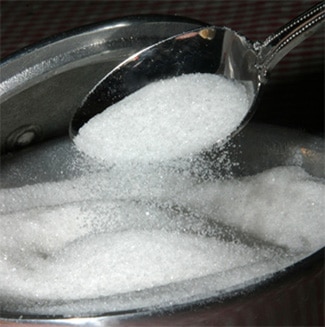November 20, 2006
Sickly Sweet

By Michael D. Shaw
Although the process of obtaining sugar from cane dates back to around 500 BC, it would not be until the 1700s that the sugar craze really took off. At this point, the Euros added much sweetness to their diets, accompanied by new levels of rotting teeth and obesity, no doubt.
Fast forward to the 1950s when every American kid was consuming breakfast cereal virtually every single day. The majority of these products already contained plenty of sugar, but we were still conditioned to add a teaspoon or so to the mix. The adults weren’t left out either: Most coffee and tea drinkers loaded up their drinks with the crystalline white stuff, and when you also include pancakes, waffles, and syrup—to say nothing of the myriad other sweet products, it’s no wonder that sugar sales were in the stratosphere.
Even though Saccharin, the first artificial sweetener, was developed in 1879, it would not be until the early 1960s when the notion of sugar substitutes would capture the public’s interest, along with health concerns about them—both real and imagined. The sugar industry was now facing some competition on two fronts: Nutritionists who simply told us to cut down on our consumption of sweets in general, and the marketing of various sugar substitutes. What’s more, food manufacturers, who had been piling on the sugar in their products, were looking at alternatives, as well.
As we head toward 2007, big sugar finds itself under attack on numerous fronts, and is fighting back. One of those fronts involves the very popular Splenda, which millions of Americans use each day to sweeten drinks, flavor foods, and improve the quality of various recipes. Alas, the battle to discredit Splenda’s safety is but the latest example of combining generic concerns over health and big government with alternative health profiteering, junk science, and scare tactics.
Strangely enough, health promoter Joseph Mercola, while pointing out the dangers of sugar, and presumably being aware of how deeply ingrained its consumption is in the diets of so many, feels the need to scare folks about Splenda. One wonders where he got his talking points, since they sure do sound as if they came from the very sugar industry he also attacks!
Let’s start by dispelling the most frequently cited lies about Splenda, that it never underwent scrutiny by the FDA and is an unnatural danger. First, Splenda was approved over eight years ago after the FDA reviewed more than 110 animal and human safety studies conducted over 20 years. But, put aside the United States for a moment, and look at the issue internationally. 78 other countries, including nations with an extremely strong emphasis on oversight and regulatory control, have approved the use of Splenda.
Does Mr. Mercola even concede this point, that an alleged conspiracy by Big Pharma can’t be both a domestic sham and a global con? If it is, then whoever arranged it should forget food products, and concentrate on pure world domination. Or, to modernize an adage attributed to Abraham Lincoln, Splenda can’t fool all of the people all of the time. Hence the problem with conspiracy theories: the facts never add up.
Often lost in the debate is the fact that sugar, as commonly used, is not a “natural” sweetener. The noted science and health writer Michael Fumento reminds us:
“If you really want natural sugar, buy a piece of sugar cane and gnaw on it. As it happens, Splenda is made from sugar just as sugar is made from cane and beets.”
Fumento’s point is well-taken—that elastic definitions of “natural” merely confuse the public, even if they serve to increase sales for certain companies. Nor does Splenda mislead consumers about this distinction; the label clearly identifies itself as a “non-nutritive sweetener.” Translation: Splenda has no calories. Chalk one up for truth in advertising.
For all his talk about being scientific, Mercola dredges up the false analogy between Splenda and “chlorinated hydrogen compounds [having] a dark history of causing serious health consequences in humans.” By this spurious logic, one should be as concerned about the toxic properties of, say, ethyl alcohol as they might be about methyl (wood) alcohol, since they are both alcohols. Or, perhaps one should eschew malic acid (a commonly used flavoring ingredient that is the natural taste component of sour fruits) since, as an “acid” it must be as dangerous as any other acid, including sulfuric.
Once you cut through all the hype, you can only conclude that the era of using sugar in excess is coming to an end, and if proven products such as Splenda help people get on the wagon, so much the better.

